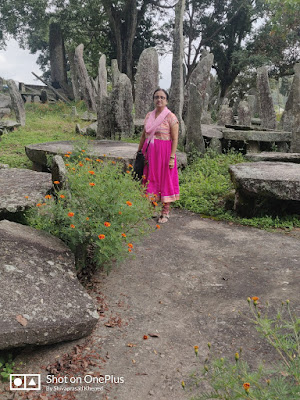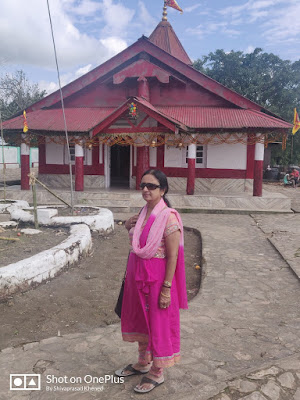This Post is courtesy my wife who insisted that I write on the Kamakhya Temple.
I am one of those who, though not an atheist, is far removed from an array of rituals, traditions, practices - with a plethora of forms and beliefs - that are central to the beauty of what Hinduism is all about. Besides, I am not well informed on matters pertaining to religious issues and therefore I never write on this subject. Yet, I am making one time exception and attempting this FB post on the Kamakhya Mandir, courtesy my wife who insisted that I write on the Kamakhya Mandir, the darshan of which my wife and I had during our short sojourn to Guwahati and Shillong on a rare vacation. She has endured the incorrigible me, when it comes to my tardiness on most family matters, for all of three decades so I better oblige.
Hinduism (सनातन धर्म) has complex roots that involve a vast array of rituals, practices and an innumerable number of deities, including the Goddess Kamakhya, in whose reverence the Kamakhya Mandir was consecrated several centuries ago, who are worshipped by Hindus. The Kamakhya Mandir is an ancient temple - a highly revered शक्तीपीठ - which is one of the best known religious centres that was famous for its mysticism and tantric practices. It is also known for a range of its sculptural art - from different times - that amalgamates myth, religion and art in an extraordinary blend. The reconstructed Kamakhya temple , which we now see, situated atop the Nilachal hill in Guwahati, dates back to sixteenth century. Decorating the walls and interiors of the temple are a range of elegantly and artistically sculpted stone images - quite similar to the Gupta art style - trace the myth behind the tantric traditions, for which the temple was known. This holy place had once become a centre that witnessed tantric sacrifices, mysticism and dark fanatics of sorcery.
Kamakhya temple is one of the main Shakti pithas (sacred place), among the fifty one शक्तीपीठ (Shatkti pithas), that is dedicated to the Mother Goddess Kamakhya - another form of the legendary Goddess Parvati. Kamakhya is worshiped in this temple in the form of ‘ womb and a Yoni’. Like most history in India, which is unclear when it comes to its exact dating or establishing its period, the Kamakhya temple too has its own share of uncertainty to its history. There is little material evidence to trace the exact period when this temple was originally built. However there are several corroborative evidences including some ancient texts - the Kallika Purana and Yogini Tantra - that do provide some reference to the antiquity of worship of Goddess Kamakhya. Based on these corroborative evidence, it has now been fairly established that the Kamakhya temple may have originally been built between 5th to 7th century A D and rebuilt several times later post it’s destruction. The temple has its own share of legendary tales.
Like the two legendary epics - Ramayana and Mahabharata - the most famous mythological stories that have transcended generations passing on from one generation to another through oral traditions, the Kamakhya temple too has its own share of oral legends and mythological beliefs. The origin of the Kamakhya temple owes its genesis to one such mythological story. Legend has it that according to the Kalika Purana, Daksha the father of Sati (Parvati) once organised an यज्ञ (sacrificial ritual) - a pious religious ceremony. In this decorated यज्ञ Daksha invited all Gods and Goddesses but excluded his daughter Sati and his son in law her Lord Shiva, who he disliked due to the so called strange appearance of Shiva and also because Shiva once ‘neglected’ him and made him wait, when he visited his daughter. On hearing the news of यज्ञ being performed by her father, Sati went to her fathers home to attend the यज्ञ without an invitation. Daksha was unimpressed to see his daughter attend his Yagna, uninvited. He angrily started insulting her husband and not withstanding the pleadings by his daughter not to insult her husband, he was unimpressed and continued insulting Lord Shiva. Sati could not bear her husbands insults any more and in uncontrollable anger she gave up her life by jumping into the fire of the यातना कुण्ड. Incidentally the necessity of diverse shapes and exacting sizes of the fire altars that were used for the यज्ञ that are responsible for the the ancient Indians to excel in mathematics. Hearing the news of his wife’s death, Shiva - known for his infamous anger - became furious and went to his father-in-law's house in a fit of rage and destroyed the sacrificial alter and then carried the dead body of his beloved wife Sati, on his shoulder and started roaming around the tribhuvana performing his तांडव - dance of distraction. Knowing well the rage of Shiva and his legendary Tandava Nritya, all Gods and Goddesses became fearful and went to seek solace with Lord Vishnu and requested him to give Mukthi to Sati. Lord Vishnu very cleverly used his legendary Vishnu Chakra to remove Satis body from the shoulders of Shiva and in the process Satis body was fragmented in to fifty one pieces and all the parts of Satis body were strewn over different places. Places where Satis body fell are consecrated as शक्तिपीठ। It is believed that one part of Satis body - the Yoni and the womb - fell on top of the Nilachala hill, which was then consecrated as the temple of Kamakhya.
It is also widely believed that the original temple was destroyed by an Islamic ruler but then it was soon reconstructed on its remains. According to an inscription on the Kamakhya temple, Koch king Naranarayana reconstructed the temple over the ruins of the old structure in 1565 A D. The nature of the current temple indicates that the original structure of the stone built temple is reconstructed many times; hence, the sculptural compositions of this temple reflect their characteristic style of different periods. Historians and archeologists have suggested that some of the stone carvings on the walls of the temple reveal the characteristic styles of the Gupta art as well as art of Orissa. Sculptures of Assam closely associated with the style of Bengal and Orissa are also seen on the temple walls. The Kamakhya temple essentially follows the Nagara style of architecture that are seen in most temples in North India. The sculptures are apparent mostly on the exterior walls as well as on the interior walls of the temple. A good number of sculptures are also fixed on the temple gates and some of these can be clearly seen in the attached photos which we clicked during our दर्शन of the deity on the 13th October. There was unending queue divided into three separate lines one for the Defence Personnel and their family one each for a special and General दर्शन। It took almost three hours for us to complete the दर्शन, not withstanding the special दर्शन that we sought. All through the queue my wife was fully engrossed in her religious thoughts and beliefs while I was trying to try and understand the art and architecture of this unique temple.
One may differ when it comes to ones religious beliefs but then one thing is a constant in India across all historical monuments - including the temples and mosques and churches and other religious and worship places - they exhibit an outstanding knowledge of ancient Indians in art, architecture and technological acumen that establishes ‘The Wonder that was India’ - borrowing from Basham.
Our trip to the North East besides Guwahati also included a visit to Shillong and its surroundings including the lesser known Nartiang Monoliths, which I managed to visit by convincing my wife that the place also has another शक्तिपीठ, the Durga Temple. The monoliths of Nartiang were truly a visual treat which can be seen in the accompanying images that I clicked.
All in all it was a memorable vacation that we enjoyed from 12th to 18th. A long waiting time in Kolkata airport helped me complete this post, which I hope pleases my wife at whose insistence I have penned this post.















3 comments:
I am a travel blogger and intrested to read about new blogs and website or there posts, recltly searching and come on to your website and found it is amazing and very inforamative.
i read multple blogs and article on your website and the post "The Kamakhya Temple in Guwahati" was amazing and i am also a travel writter if you like or want to know about kamakhya temple you can follow me.
The Trimbakeshwar Temple is an ancient temple of the Shivlinga (Trimbakeshwar Jyotirlinga), which has three faces symbolizing Lord Brahma, Vishnu, and Shiva (Lord Mahesh). Of the twelve Jyotirlingas located in the Nashik district, Trimbakeshwar is famous for its Jyotirlinga.Purohit Sangh Guruji,Narayan Nagbali,Kalsarpadosh, Tripindi Shradh, Mahamrityunjaya Mantra.
Post a Comment